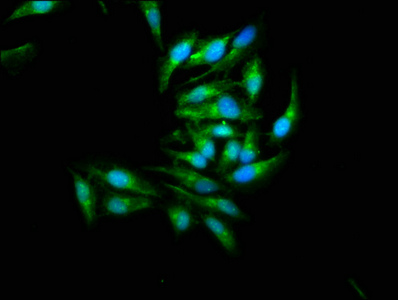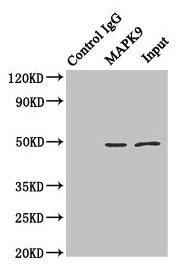
Immunofluorescence staining of Hela cells with CSB-PA013471LA01HU at 1:266, counter-stained with DAPI. The cells were fixed in 4% formaldehyde, permeabilized using 0.2% Triton X-100 and blocked in 10% normal Goat Serum. The cells were then incubated with the antibody overnight at 4°C. The secondary antibody was Alexa Fluor 488-congugated AffiniPure Goat Anti-Rabbit IgG(H+L).
MAPK9 Antibody

CSB-PA013471LA01HU
ApplicationsImmunoFluorescence, ImmunoPrecipitation, ELISA
Product group Antibodies
ReactivityHuman
TargetMAPK9
Overview
- SupplierCusabio
- Product NameMAPK9 Antibody
- Delivery Days Customer20
- ApplicationsImmunoFluorescence, ImmunoPrecipitation, ELISA
- CertificationResearch Use Only
- ClonalityPolyclonal
- ConjugateUnconjugated
- Gene ID5601
- Target nameMAPK9
- Target descriptionmitogen-activated protein kinase 9
- Target synonymsc-Jun kinase 2; c-Jun N-terminal kinase 2; JNK2; JNK2A; JNK2ALPHA; JNK2B; JNK2BETA; JNK-55; Jun kinase; MAP kinase 9; MAPK 9; mitogen-activated protein kinase 9; p54a; p54aSAPK; PRKM9; SAPK; SAPK1a; stress-activated protein kinase 1a; stress-activated protein kinase JNK2
- HostRabbit
- IsotypeIgG
- Protein IDP45984
- Protein NameMitogen-activated protein kinase 9
- Scientific DescriptionSerine/threonine-protein kinase involved in various processes such as cell proliferation, differentiation, migration, transformation and programmed cell death. Extracellular stimuli such as proinflammatory cytokines or physical stress stimulate the stress-activated protein kinase/c-Jun N-terminal kinase (SAP/JNK) signaling pathway. In this cascade, two dual specificity kinases MAP2K4/MKK4 and MAP2K7/MKK7 phosphorylate and activate MAPK9/JNK2. In turn, MAPK9/JNK2 phosphorylates a number of transcription factors, primarily components of AP-1 such as JUN and ATF2 and thus regulates AP-1 transcriptional activity. In response to oxidative or ribotoxic stresses, inhibits rRNA synthesis by phosphorylating and inactivating the RNA polymerase 1-specific transcription initiation factor RRN3. Promotes stressed cell apoptosis by phosphorylating key regulatory factors including TP53 and YAP1. In T-cells, MAPK8 and MAPK9 are required for polarized differentiation of T-helper cells into Th1 cells. Upon T-cell receptor (TCR) stimulation, is activated by CARMA1, BCL10, MAP2K7 and MAP3K7/TAK1 to regulate JUN protein levels. Plays an important role in the osmotic stress-induced epithelial tight-junctions disruption. When activated, promotes beta-catenin/CTNNB1 degradation and inhibits the canonical Wnt signaling pathway. Participates also in neurite growth in spiral ganglion neurons. Phosphorylates the CLOCK-ARNTL/BMAL1 heterodimer and plays a role in the regulation of the circadian clock. MAPK9 isoforms display different binding patterns: alpha-1 and alpha-2 preferentially bind to JUN, whereas beta-1 and beta-2 bind to ATF2. However, there is no correlation between binding and phosphorylation, which is achieved at about the same efficiency by all isoforms. JUNB is not a substrate for JNK2 alpha-2, and JUND binds only weakly to it.
- ReactivityHuman
- Storage Instruction-20°C or -80°C
- UNSPSC12352203

